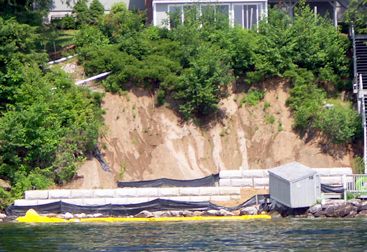MAXUM is correct about
silt.
"Silt" is
inorganic in origin:
Dense forest growth (especially pine) reduces the amount of silt washed downslope by heavy rains
everywhere in the Winnipesaukee Basin.
Last week, I checked out the source of a loud wood-chipper sound nearby. It was a new neighbor who had cut down eight huge White Pines from his shorefront. The nearest stump to be seen was about 30-inches across. (The width of a typical refrigerator). The "trimmer's" name? "
Urban Tree Service".

Wave actions—but especially large boat wakes—wash heavier silt from shorefronts. While some "silt" washed downslope introduces "sand"—where it didn't appear before—the finer particles can be expected to coat the lake's bottom
locally.
For example, three decades of construction on The Broads side of Wolfeboro Neck—and Rattlesnake Island—has changed those locales. By kayak, I remember seeing a kaleidoscope of colors and textures on every rock on the bottom. Presently, they all appear similarly-textured and "olive" in color. 'Wonder why?



In some states, a "Rain Tax" would have been imposed on the abutters!

Is "Rain Tax" another name for "View Tax"?

________________________
Canada Geese may be getting a "bad rap" for Gilford's waters. DNA examinations—
which may be in process presently—can determine if the source of
E. coli is mammal, fish,
vegetable, or (foul) fowl. Presently, the entire state of New Hampshire is affected by an outbreak:
http://www.ecoliblog.com/e-coli-outb...9#.V53iO-RTF-w
While
FLL's referenced article has expired for non-subscribers,
The Citizen newspaper has published many
E. coli articles just for the year 2016:
http://www.citizen.com/search/node/coli
Also remember that Canada Geese are "invited" to the area by
maintaining green-grass lawns.

The nutrients of Phosphorus and Nitrogen from lawn fertilizers "grow" the lake's algae—and the algae "grow" the snails that produce Duck Itch.
 .
.